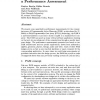Free Online Productivity Tools
i2Speak
i2Symbol
i2OCR
iTex2Img
iWeb2Print
iWeb2Shot
i2Type
iPdf2Split
iPdf2Merge
i2Bopomofo
i2Arabic
i2Style
i2Image
i2PDF
iLatex2Rtf
Sci2ools
NIXDORF
1992
1992
Programmable Active Memories: A Performance Assessment
We present some quantitative performance measurements for the computing power of Programmable Active Memories (PAM), as introduced by [2]. Based on Field Programmable Gate Array (FPGA) technology, the PAM is a universal hardware co-processor closely coupled to a standard host computer. The PAM can speed up many critical software applications running on the host, by executing part of the computations through a speci
c hardware design. The performance measurements presented are based on two PAM architectures and ten speci
c applications, drawn from arithmetics, algebra, geometry, physics, biology, audio and video. Each of these PAM designs proves as fast as any reported hardware or super-computer for the corresponding application. In cases where we could bring some genuine algorithmic innovation into the design process, the PAM has proved an order of magnitude faster than any previously existing system (see [19] and [18]). 1 PAM concept Like any RAM memory module, a PAM is attached to t...
| Added | 10 Aug 2010 |
| Updated | 10 Aug 2010 |
| Type | Conference |
| Year | 1992 |
| Where | NIXDORF |
| Authors | Patrice Bertin, Didier Roncin, Jean Vuillemin |
Comments (0)

